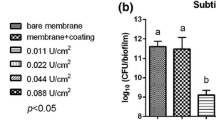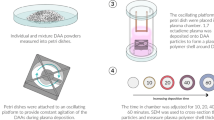Abstract
Objectives
To investigate the ability of the proteases, subtilisin and α-chymotrypsin (aCT), to inhibit the adhesion of Candida albicans biofilm to a polypropylene surface.
Results
The proteases were immobilized on plasma-treated polypropylene by covalently linking them with either glutaraldehyde (GA) or N′-diisopropylcarbodiimide (DIC) and N-hydroxysuccinimide (NHS). The immobilization did not negatively affect the enzyme activity and in the case of subtilisin, the activity was up to 640% higher than that of the free enzyme when using N-acetyl phenylalanine ethyl ester as the substrate. The efficacies against biofilm dispersal for the GA-linked SubC and aCT coatings were 41 and 55% higher than the control (polypropylene coated with only GA), respectively, whereas no effect was observed with enzymes immobilized with DIC and NHS. The higher dispersion efficacy observed for the proteases immobilized with GA could be both steric (proper orientation of the active site) and dynamic (higher protein mobility/flexibility).
Conclusions
Proteases immobilized on a polypropylene surface reduced the adhesion of C. albicans biofilms and therefore may be useful in developing anti-biofilm surfaces based on non-toxic molecules and sustainable strategies.


Similar content being viewed by others
References
Biniarz P, Spadoni Andreani E, Krasowska A, Secundo F (2015) Effect of immobilized proteases on bacterial growth and cell adhesion on polypropylene surfaces. J Clin Microbiol Biochem Technol 2:7–9
Connolly LA, Riccombeni A, Grózer Z, Holland LM, Lynch DB, Andes DR, Gácser A, Butler G (2013) The apses transcription factor efg1 is a global regulator that controls morphogenesis and biofilm formation in Candida parapsilosis. Mol Microbiol 90:36–53
Cordeiro AL, Hippius C, Werner C (2011) Immobilized enzymes affect biofilm formation. Biotechnol Lett 33:1897–1904
Heras B, Totsika M, Peters KM, Paxman JJ, Gee CL, Jarrott RJ, Perugini MA, Whitten AE, Schembri MA (2014) The antigen 43 structure reveals a molecular velcro-like mechanism of autotransporter-mediated bacterial clumping. Proc Natl Acad Sci USA 111:457–462
Monniot C, Boisramé A, Da Costa G, Chauvel M, Sautour M, Bougnoux ME, Bellon-Fontaine MN, Dalle F, d’Enfert C, Richard ML (2013) Rbt1 protein domains analysis in Candida albicans brings insights into hyphal surface modifications and rbt1 potential role during adhesion and biofilm formation. PLoS ONE 8:e82395
Mootz JM, Malone CL, Shaw LN, Horswill AR (2013) Staphopains modulate Staphylococcus aureus biofilm integrity. Infect Immun 81:3227–3238
Nailis H, Vandenbroucke R, Tilleman K, Deforce D, Nelis H, Coenye T (2009) Monitoring als1 and als3 gene expression during in vitro Candida albicans biofilm formation under continuous flow conditions. Mycopathologia 167:9–17
Park JH, Lee JH, Kim CJ, Lee JC, Cho MH (2012) Lee J (2012) Extracellular protease in Actinomycetes culture supernatants inhibits and detaches Staphylococcus aureus biofilm formation. Biotechnol Lett 34:655–661
Sadekuzzaman M, Yang S, Mizan MFR, Ha SD (2015) Current and recent advanced strategies for combating biofilms. Comp Rev Food Sci Food Safety 14:491–509
Secundo F, Spadaro S, Carrea G, Overbeeke PLA (1999) Optimization of Pseudomonas cepacia lipase preparations for catalysis in organic solvents. Biotechnol Bioeng 62:554–561
Secundo F, Barletta GL, Parini G, Roda G (2012) Effects of stabilizing additives on the activity of alpha-chymotrypsin in organic solvent. J Mol Catal B Enzym 84:128–131
Spadoni AE, Magagnin L, Secundo F (2016) Preparation and Comparison of Hydrolase-Coated Plastics. ChemistrySelect 1:1490–1495
Srivastava S, Bhargava A (2016) Biofilms and human health. Biotechnol Lett 38:1–22
Tahir MN, Cho E, Mischnick P, Lee JY, Yu JH, Jung S (2014) Pentynyl dextran as a support matrix for immobilization of serine protease subtilisin carlsberg and its use for transesterification of n-acetyl-l-phenylalanine ethyl ester in organic media. Bioproc Biosyst Eng 37:687–695
Thewes S, Moran GP, Magee BB, Schaller M, Sullivan DJ, Hube B (2008) Phenotypic screening, transcriptional profiling, and comparative genomic analysis of an invasive and non-invasive strain of Candida albicans. BMC Microbiol 8:187
Verstrepen KJ, Klis FM (2006) Flocculation, adhesion and biofilm formation in yeasts. Mol Microbiol 60:5–15
Villa F, Pitts B, Stewart PS, Giussani B, Roncoroni S, Albanese D, Giordano C, Tunesi M, Cappitelli F (2011) Efficacy of zosteric acid sodium salt on the yeast biofilm model Candida albicans. Microb Ecol 62:584–598
Acknowledgements
We thank for financial support Fondazione Cariplo (Grant No. 2011-0277) and the Italian Ministry of Foreign Affairs, General Directorate for Cultural Promotion and Collaboration, which supported this work within the frame of the Executive Programme of Scientific and Technological Cooperation between the Italian Republic and the Republic of Poland for the years 2013–2015 (Prot. nr. 0086269, 17/04/2013; Prot. nr. 90692, 17/04/2014, Prot. nr. 75740, 10/04/2015).
Author information
Authors and Affiliations
Corresponding author
Additional information
Eugenio Spadoni Andreani, Federica Villa contributed equally to this work.
Rights and permissions
About this article
Cite this article
Andreani, E.S., Villa, F., Cappitelli, F. et al. Coating polypropylene surfaces with protease weakens the adhesion and increases the dispersion of Candida albicans cells. Biotechnol Lett 39, 423–428 (2017). https://doi.org/10.1007/s10529-016-2262-5
Received:
Accepted:
Published:
Issue Date:
DOI: https://doi.org/10.1007/s10529-016-2262-5




